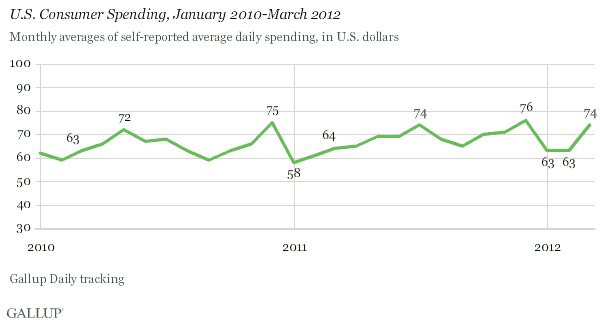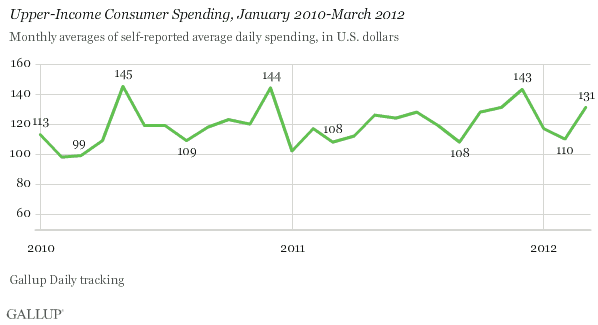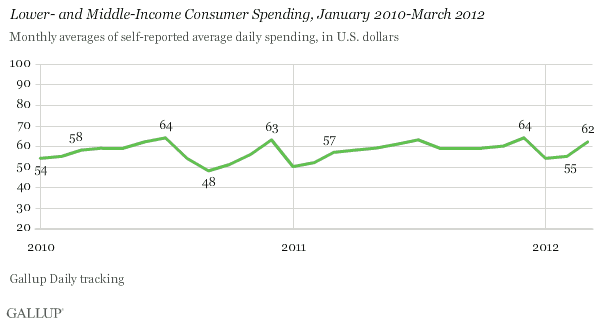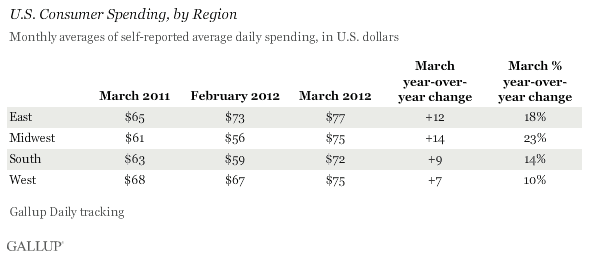PRINCETON, NJ -- Americans' self-reported daily spending in stores, restaurants, gas stations, and online averaged $74 per day in March, up from $63 in February, and up 16% compared with the same month a year ago ($64). The best economic confidence in four years, strong job creation, higher gas prices, warmer weather than usual, and a relatively early Easter are likely responsible for sending self-reported consumer spending up in March.

Gallup's spending results reflect self-reported spending perceptions and focus to a large degree on nondurable discretionary spending items. As a result, they tend to reflect higher average daily values and a larger percentage change than most other measures of consumer spending.
Over the past three years, consumer spending in March has been in a relatively tight $59 to $64 range. This "new normal" range followed the recession and financial crisis of 2008-2009. In contrast, overall spending averaged $81 in March 2008, when the recession was just getting underway.
Upper-Income Spending Surges
Spending among Americans making at least $90,000 a year averaged $131 per day in March, up from $110 in February -- and up 21% from March 2011. This group's spending last month was at its highest level for the month of March since Gallup Daily tracking began in 2008.

Lower- and Middle-Income Americans' Spending Also Increases
Americans who make less than $90,000 per year reported spending an average of $62 per day during March, up from $55 in the prior month, and up 9% from the same month a year ago. Lower- and middle-income spending has been in a new normal range of $52 to $58 in March over the past three years. This group's spending averaged $74 in March 2008.

Americans' Spending Up in All Regions
Spending across all regions was higher in March than in February. Year over year, the largest increase took place in the Midwest -- up 23% -- followed by the East, where spending was up 18%. Smaller increases occurred in the South, at 14%, and the West, at 10%.

Implications
March's sharp 16% increase in year-over-year consumer spending is consistent with Gallup's other behavioral economic measures and with the positive March sales reports from many of the nation's retailers. Although Gallup's consumer spending results often differ from those of retail sales, they are frequently well aligned with chain-store sales.
The March increase in consumer spending may be partly related to improvements in the job situation earlier this year. Gallup modeling suggests consumer spending tends to increase four to eight weeks after substantial job growth, particularly among low- and moderate-income consumers. The strong stock market performance of the first quarter and the related "wealth effect" has also likely had a positive impact on spending, particularly for upper-income Americans.
Further, while increasing gas prices often lead consumers to pull back on their overall spending, it tends to take consumers some time to adjust to them. As a result, higher gas prices can increase spending in the immediate term but have the opposite effect over the intermediate term.
Warm weather may also have helped sales, not only by getting more people out to the stores, but also in terms of clothing and other spring item sales. Year over year, the early Easter this year is also likely to have provided a boost to March sales compared with those of a year ago.
Whatever the reasons, consumer spending pulled out of the doldrums of the past three years in March 2012. This is good news for the nation's retailers and for the Americans who get the new jobs higher spending may create. What's most important, however, is that the economy build on this positive momentum in the months ahead.
Gallup.com reports results from these indexes in daily, weekly, and monthly averages and in Gallup.com stories. Complete trend data are always available to view and export in the following charts:
Daily: Employment, Economic Confidence, Job Creation, Consumer Spending
Weekly: Employment, Economic Confidence, Job Creation, Consumer Spending
Read more about Gallup's economic measures.
View our economic release schedule.
Survey Methods
For Gallup Daily tracking, Gallup interviews approximately 1,000 national adults, aged 18 and older, each day. The consumer spending results are based on a random sample of approximately 500 current full- and part-time employees each day.
National results for March are based on Gallup Daily tracking interviews with 15,243 national adults conducted March 1-31, 2012. For this sample, one can say with 95% confidence that the maximum margin of sampling error is ±1 percentage point.
Upper-income results are based on Gallup Daily tracking interviews with 2,850 national adults conducted March 1-31, 2012. For this sample, one can say with 95% confidence that the maximum margin of sampling error is ±3 percentage points.
Middle- and lower-income results are based on Gallup Daily tracking interviews with 9,885 national adults conducted March 1-31, 2012. For this sample, one can say with 95% confidence that the maximum margin of sampling error is ±1 percentage point.
Regional results are based on Gallup Daily tracking interviews with more than 3,000 national adults per region conducted March 1-31, 2012. For this sample, one can say with 95% confidence that the maximum margin of sampling error is ±3 percentage points.
Interviews are conducted with respondents on landline telephones and cellular phones, with interviews conducted in Spanish for respondents who are primarily Spanish-speaking. Each sample includes a minimum quota of 400 cell phone respondents and 600 landline respondents per 1,000 national adults, with additional minimum quotas among landline respondents by region. Landline telephone numbers are chosen at random among listed telephone numbers. Cell phone numbers are selected using random-digit-dial methods. Landline respondents are chosen at random within each household on the basis of which member had the most recent birthday.
Samples are weighted by gender, age, race, Hispanic ethnicity, education, region, adults in the household, and phone status (cell phone only/landline only/both, cell phone mostly, and having an unlisted landline number). Demographic weighting targets are based on the March 2011 Current Population Survey figures for the aged 18 and older non-institutionalized population living in U.S. telephone households. All reported margins of sampling error include the computed design effects for weighting and sample design.
In addition to sampling error, question wording and practical difficulties in conducting surveys can introduce error or bias into the findings of public opinion polls.
For more details on Gallup's polling methodology, visit www.gallup.com.